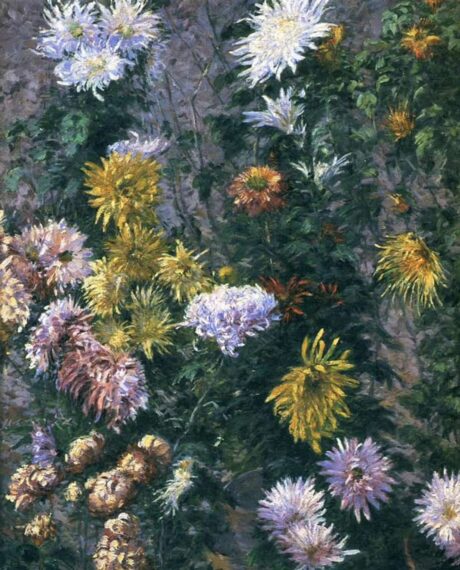
Notes on a Flower: Chrysanthemums in Japan and France
April 24, 2025—In 1897, the French Impressionist painter Claude Monet made four paintings of the chrysanthemums in his garden in Giverny. He had been an avid collector of Japanese prints since the 1870s, and his unexpected, expressive use of space in this experiment recalls the Large Flowers series of prints made between 1833 and 1834 by renowned Japanese painter and print designer Katsushika Hokusai.
Mia’s ongoing exhibition “Hokusai | Monet” brings the Large Flowers and Chrysanthemums series into conversation, exploring the artistic connections between Japan and France in the 19th century. Here, we take a closer look at the flower at the center of it all, the chrysanthemum, and what its motif represents in Japanese and French contexts—and what broader meanings it may have engendered for each of these prolific artists.

Katsushika Hokusai (Japanese,1760–1849), Chrysanthemums and Horsefly, c. 1833–34, ink and color on paper. Bequest of Richard P. Gale, 74.1.210
Symbolism and Subversion in Japan

Japan’s Imperial Seal
Chrysanthemums, or kiku, are an enduring symbol in Japanese culture. Since the Kamakura period (1185–1333), these flowers have long been associated with the Japanese imperial family. A gold, 16-petal chrysanthemum serves as Japan’s Imperial Seal, found on passports, the 50-yen coin, in Shinto shrines, and at embassies worldwide. Each fall, the Kiku Matsuri, or chrysanthemum festival, showcases a dizzying variety of chrysanthemums cultivated by the Bunkyō Chrysanthemum Cultivation Society in Tokyo. There’s even an award: the Supreme Order of the Chrysanthemum, the highest honor a Japanese citizen can receive.
It’s interesting, then, that in Chrysanthemums and Horsefly, Hokusai chose to pair chrysanthemums with a common horsefly. His choice suggests a more subversive interpretation of the flower, away from its high status as an imperial symbol. In pairing these seemingly disparate elements, Hokusai may have been signaling his artistic independence and subtle resistance to depicting what was conventional and expected.

View of the exhibition “Hokusai / Monet” installed in Cargill Gallery at Minneapolis Institute of Art. Exhibition on view at Mia February 8, 2025 – August 10, 2025.
Loss, Friendship, and Artistic Connections in France
Chrysanthemums occupy a fairly somber place in French culture. Strongly associated with death and mourning, they’re commonly seen in November on All Saints’ Day, or La Toussaint. During this French national holiday, people gather with their families and remember lost loved ones.
When the Impressionists were active, though, the presence of chrysanthemums in art was part of a broader artistic trend, as the flowers were celebrated for their connections to East Asian art and culture, which captivated European society at the time.
Monet had a particular affinity for them. His painting Chrysanthemums (1897), painted in his garden at Giverny, showcases the flowers’ brilliant pink, red, and gold hues. The work is notable for being his first experiment with the “flat” Japanese composition style.
“I perhaps owe it to flowers that I became a painter.”
—Claude Monet, 1927

Gustave Caillebotte, Chrysanthèmes blancs et jaunes, jardin du Petit-Gennevilliers, 1893, oil on canvas, 28¾ in. x 23½ in. (73 x 60 cm). Musée Marmottan, Paris
Another Impressionist artist with a well-documented love of chrysanthemums was Monet’s close friend and fellow gardener, Gustave Caillebotte. Monet and Caillebotte supported each other’s artistic and horticultural pursuits. In 1893, the year before his death, Caillebotte created six paintings of chrysanthemums. Three of these depict the canvas filled entirely with flowers, without a visible horizon, preempting Monet’s later chrysanthemum compositions. Caillebotte gave one of these paintings to Monet as a gift.
It’s entirely likely, then, that Caillebotte was on Monet’s mind as he painted his own chrysanthemum series three years later, and that these flowers may have represented something beyond their established connotations—a colorful tribute to a beloved friend.
Rich with symbolic meaning across cultural contexts, chrysanthemums reflect an age-old artistic appreciation for beauty and impermanence. Their prominence in the works of Hokusai and Monet invites viewers to appreciate the deeper meanings behind a vibrant bloom.
About the Exhibition
“Hokusai | Monet” is on view through August 10, 2025, in the Cargill Gallery.
